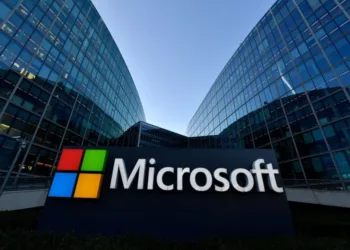Apple is making a historic move by committing a massive $500 billion investment in the United States over the next four years. This decision, seen as a strategic attempt to mitigate the impact of tariffs imposed by former President Donald Trump, will drive innovation, create jobs, and strengthen the tech giant’s foothold in the country. But what does this really mean for Apple, the U.S. economy, and consumers? Let’s dive into the details.
Table of Contents
Apple’s Billion-Dollar Bet: A Response to Trump’s Trade Policies?
The decision to invest half a trillion dollars is likely influenced by Trump’s strict tariff policies, which have put pressure on Apple’s supply chain and profitability. With these tariffs potentially driving up costs for imported components, Apple is taking proactive steps to localize more of its operations, reduce reliance on overseas manufacturing, and potentially earn some political goodwill.
Key Highlights of Apple’s U.S. Investment Plan:
- $500 billion to be invested across multiple projects over the next four years.
- A new server facility in Houston will be constructed.
- 20,000 new jobs will be created in the U.S., focusing on AI, chip engineering, and R&D.
- A supplier academy in Michigan and a manufacturing academy in Detroit will be established to support mass production and smaller tech firms.
- Expansion of data centers in Arizona, Oregon, Iowa, Nevada, and North Carolina.

Apple’s Strategic Expansion: A Game-Changer for the U.S. Tech Ecosystem
Apple’s move to invest heavily in the U.S. is not just about tariffs—it’s also a major step in securing its long-term future. The addition of 20,000 jobs will boost employment in AI, chip engineering, and research & development, fields that are crucial for Apple’s next generation of products.
Moreover, the supplier academy in Michigan and the manufacturing academy in Detroit will empower smaller businesses, fostering a more resilient and independent domestic supply chain.
Apple’s previous commitments to investing in the U.S. were already significant, but this new $500 billion pledge marks a sharp increase over prior plans. In 2021, Apple had committed to investing $430 billion over five years. The additional $70 billion indicates the urgency with which Apple is responding to changing trade dynamics and economic pressures.
Why is Apple Expanding Its Data Centers?
One of the major aspects of Apple’s investment plan is the expansion of its data center capacity across Arizona, Oregon, Iowa, Nevada, and North Carolina. Data centers are a crucial part of Apple’s cloud services, which support millions of iCloud users, app developers, and AI-driven applications.
How Data Centers Strengthen Apple’s Infrastructure
- Increased Security and Privacy: Apple places a high priority on data privacy, and having more U.S.-based data centers means greater control over security protocols and compliance with American regulations.
- Improved Service Performance: More data centers mean reduced latency and faster performance for iCloud, App Store, and AI-driven applications like Siri.
- Support for AI and Machine Learning: Apple’s growing focus on AI requires significant computing power, and localizing these data centers ensures more efficient processing and innovation.
The Impact on Apple’s Product Pricing & Profitability
Trump’s tariffs have put Apple in a tough spot: either increase product prices to offset costs or absorb the financial hit, leading to reduced earnings. Here’s what analysts predict:
- If Apple raises product prices by 9%, it could offset the tariffs but risk lower sales.
- If Apple absorbs the costs, its earnings could drop by 3.1% in 2026.
- A modest 3% price increase would still result in a 2.4% decline in annual revenue.
This explains why Apple is making such a massive investment—it needs to avoid price hikes that could turn away customers while also ensuring profitability.
Apple has traditionally avoided major price hikes unless necessary, as seen in previous product generations. Instead, the company often focuses on supply chain efficiencies, software monetization, and increased product longevity to maintain profitability.

What About Apple’s Silicon Production?
Despite this large-scale U.S. expansion, Apple’s powerful M-series chips will still be produced by TSMC in Taiwan. While the company is localizing other parts of its supply chain, it remains reliant on TSMC’s cutting-edge semiconductor technology for now.
Apple’s long-term goal, however, is to shift more chip production to the U.S. The company has already partnered with TSMC to build a chip manufacturing facility in Arizona, which is expected to begin production in the coming years. If successful, this could reduce Apple’s dependence on overseas semiconductor manufacturing and enhance supply chain resilience.
How Will This Affect Apple’s Global Competitiveness?
Apple’s decision to invest heavily in the U.S. could have significant global implications. With tensions between the U.S. and China escalating over trade and technology, Apple is wisely diversifying its production and supply chain to reduce risk.
Potential Global Advantages:
- Reduced Dependence on China: By manufacturing more components in the U.S., Apple is less vulnerable to geopolitical tensions and supply chain disruptions.
- Better Regulatory Compliance: Localizing production helps Apple comply with U.S. regulations, avoiding unexpected policy shifts that could impact global operations.
- Strengthened Brand Image: Apple’s investment reinforces its commitment to job creation and economic growth, which can bolster its reputation among American consumers.
However, there are also challenges. U.S.-based manufacturing is typically more expensive than overseas production, which could impact Apple’s profit margins. Balancing cost efficiency while maintaining high-quality production will be a crucial test for the company.
What This Means for Consumers & the Future of Apple
Apple’s $500 billion commitment signals a major shift toward more U.S.-based production and innovation. For consumers, this could mean:
- Potentially more competitive pricing as Apple finds ways to offset tariffs.
- Faster product development thanks to localized research and chip engineering.
- A boost to the U.S. job market and tech sector, fostering more innovation within the country.
Apple is playing the long game, ensuring its dominance in the market while adapting to changing economic policies. This record-breaking investment could redefine its manufacturing strategy and set new benchmarks for the tech industry.
Final Thoughts
Apple’s decision to pump $500 billion into the U.S. economy is more than just a reaction to tariffs—it’s a strategic move to strengthen its supply chain, innovate faster, and create jobs. While challenges remain, including semiconductor dependency and potential cost hikes, this investment could ultimately reshape the future of Apple and the broader tech industry.
As the global tech landscape shifts, Apple’s investment strategy will be closely watched. Whether this move helps Apple maintain its dominance or creates unforeseen challenges remains to be seen.
What do you think about Apple’s move? Will it help the company avoid major price increases, or is it simply a reaction to political pressures? Share your thoughts in the comments!








